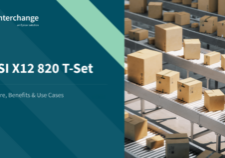How to Unite Emerging Supply Chain Management Technology Trends
Supply chains are constantly evolving, and technology is playing a crucial part in this evolution. Supply chain management and new technology have always gone hand in hand. Recently we have seen the emergence of numerous trends that will have a profound effect on supply chains — now and in the future.
For new supply chains to flourish, businesses have always needed a way to bring together various technologies to create supply chain best practices and provide a competitive edge. Fundamentally, that unifying force can and should be a comprehensive EDI (Electronic Data Interchange) solution.
Since the mid-20th Century, EDI has been the beating heart of supply chain management and supply chain communication. Of course, such legacy solutions present challenges within a contemporary context, and modern updates are required to ensure easy access and effective analysis of outputs.
Trends in EDI development are critical to understanding how more effective management of broader technology trends is made possible. However, we need to first address these trends one at a time in order to understand the opportunities and challenges that will define the future of supply chain management.
Suggested reading: If you want a detailed exploration of how EDI trends can be harnessed to create a competitive advantage, check out the eBook — The Supply Chain Centred Business.
Understanding supply chain trends
Businesses have always looked to technology to evolve their supply chain operations. The difference today is that existing processes must be examined to ensure waste is being taken out of existing supply chains. Velocity and certainty must be increased.
So, what are the fundamental goals of the new supply chains?
- Customer-centric — anticipating customer needs: Consumers expect the ability to purchase what they need, when they need it, in the right quantities, no matter how or where an order is placed.
- Dynamic — Responding to change: Change is now a given, and the recent supply chain upheavals have to be considered closer to the norm than as black swan events.
- Strategic — Evolving a competitive supply chain strategy: Designing and building the right supply chain will be one of the most powerful ways to maintain an edge over the competition, to move faster, deliver more value, and be more flexible in the face of both steady-state and left-field changes.
From this context, we can identify four major technology trends that will have a significant impact on supply chain best practices, and need to be considered within future strategies.
Trend 1: Artificial intelligence (AI)
The global AI supply chain market is expected to grow at a CAGR of 45.3% from 2019 to $21.8bn by 2027. AI has so many applications in the supply chain — some we probably haven’t thought of yet. The current front-runners include:
- Autonomous vehicles
- Supply and demand planning
- Data analysis
- Warehouse management
Why it’s important
AI brings in software and systems to emulate and improve on human intelligence and behaviour. Machine learning and AI can modify the behaviour of the supply chain faster and with more rigour than people could manage. This allows you to detect patterns and gaps, produce forecasts and deliver insights and actions at speed.
Challenges/risks posed
AI only delivers outputs as valuable as the inputs provided. Up-to-date and accurate data is vital for any AI system. It’s a non-trivial task to integrate with systems and databases with a rigorous process for accessing, cleansing, and analysing data. Furthermore, AI doesn’t work in isolation. While it’s a brilliant way to understand your data, enhance efficiency, and drive new actions, it can’t be left to manage your supply chain on its own.
Best practice approach
Automating the transfer of information and generating a single-source-of-truth for supply chain management is critical to the effective deployment of AI. It’s needed to accurately capture the right data, and then roll out insights across your system. Fundamentally, EDI solutions can make this possible, putting EDI front-and-centre when it comes to effective deployment of AI within a supply chain context.
Furthermore, trust then verify should be your watchword of AI. Supply chain professionals should run periodic checks against models and actions to ensure everything is working within expected boundaries. This keeps human decision-making in the loop, simply allowing you to make the right choice faster.
Trend 2: Robotics
Robots are starting to deliver on their long-waited-for promise. Modern supply chain robots can improve the accuracy and speed of routine operations while adding efficiency and safety across supply-chain practices.
Influenced by social distancing, the adoption rate for robotics and automation increased more than any other supply-chain technology during 2020. But businesses have to be aware of the sensitivities and challenges robotics may introduce in the job market.
Why it’s important
Advancements in robotics are contributing towards broader supply chain management goals. These include:
- Cutting down/eliminating manual operations
- Improving safety
- Reducing human error
- Driving efficiencies
Challenges/risks posed
Knowing when and how to deploy robotics is critical, and finding ways to improve communication between robotic and human operators is important for future success. High-profile incidents of injuries have elevated the standard of success — although, it has to be noted that robotics present the opportunity to create a safer workplace. There is also the reality that robotics pose a threat to the job security of lower-skilled workers, making this a particularly sensitive topic
Best practice approach
Having full visibility over your supply chain can help plan when and how to deploy robotics to best effect, and project the impact that robotic implementations will have on jobs, safety and communication. Again, EDI is a fundamental part of making this visibility possible, and can help share information between robotic processes and human operations. It’s critical to take a holistic view of supply chain management, not only focusing on automotive individual tasks, but looking at how robotics can be integrated into a broader and seamless system.
Give your business a competitive edge and implement an EDI-enabled supply chain today!
Download our FREE eBook to find out how>>
Trend 3: The Internet of Things (IoT)
The Internet of Things (IoT) is a vast network of low-cost interconnected sensors. These devices can track and authenticate products and shipments in the supply chain as they progress on a massive scale.
Why it’s important
Collecting data through connected devices allows businesses to discover new trends, improve real-time communications and strategic decision-making. It also surfaces data that was previously hidden or poorly understood. Benefits of IoT to supply chain management include:
- Tracking speed and movement of goods
- Monitoring storage conditions
- Locating goods in storage
IoT, itself, helps automate supply chain management. It also provides data that can help inform robotic deployment, and, fundamentally, increases data visibility over your entire operation.
Challenges/risks posed
Cyber security is a significant challenge. For example, the now-infamous malware Stuxnet demonstrated how vulnerable an integrated supply chain can be to computer viruses. IoT also presents a data problem. The amount of information generated needs to be captured and stored to be of use, and building a solution that’s able to effectively harness that data is critical to making the application of IoT worthwhile.
Best practice approach
Start with a limited pilot. For example, RFID tags and sensors can help with EDI-based inventory accounting or status, improving stocking and increasing profits. Consider using IoT in logistics to monitor operations, increase supply chain visibility and reduce costs. However, as you expand your IoT deployment, ensuring that the information generated is captured within your EDI system is critical to maintaining single-source-of-truth visibility over your supply chain operation.
Trend 4: 5G Networks
There has been so much hype about 5G, and it is still in the early stages. But the connectivity and speed of 5G will provide the network to deliver truly agile supply chains and enable unhindered digital communication across wireless networks.
Why it’s important
This technology isn’t just about speed; it’s about latency and device density. Many developments (such as IoT) are waiting for the impending arrival of 5G networks to take advantage of this. 5G shouldn’t be viewed as a simple upgrade in 4G, but an unleashing of wireless communication capabilities that changes what it’s possible to do.
Challenges/risks posed
5G coverage will be patchy, and that could have a significant impact on supply chain visibility.
Some aspects of 5G rollout are still very much wait-and-see, and you will have to keep a careful eye on developments before making any significant investments in 5G.
Best practice approach
In the new hyperconnected world, 5G alone will not transform the organisation. As businesses begin adopting 5G, they will need to take a step back and radically reinvent some of their existing data infrastructures to exploit the opportunities ahead. Again, having supply chain visibility unlocks the real potential for 5G deployments, and EDI is critical to making that planning and evaluation possible.
Bring these supply chain trends together using next-level EDI
EDI (Electronic Data Interchange) has historically provided the technical framework for automated supply chain management. EDI will still be vital for making the most of these technology trends, and can break down technology silos, build on existing best practices and flexibly accommodate change.
However, to do this, EDI itself has to evolve. It’s critical to create a seamless and simple solution that can maximise EDI adoption across your supply chain and provide complete visibility. To do this, a number of factors have to be considered:
- Hybrid EDI: There are multiple types of EDI, each with its own strengths and weaknesses. For example, Web EDI form allows for simple access to partners with limited supply chain experience, but does not provide the same level of sophistication and automation as EDI via VAN and point-to-point solutions. Your system needs to use each type of EDI to best effect, and ensure seamless communication across all deployments.
- Automation and analytics: With so much data flowing through your EDI system, it’s important to deploy analytics capabilities to better understand supply chain processes. It’s also critical to access software solutions like EDI mapping to maximise EDI standard and protocol flexibility in order to ensure partner access to your EDI solution. Modern EDI solutions enable that visibility through cloud-based analytics and control functions that improve the outcome of your system.
- Managed services: Access to on-demand expertise can help smooth any challenges within your EDI solution that cannot be solved by automated tools. For any organisation without significant in-house EDI expertise, managed EDI services are important to ensure seamless supply chain management.
The combination of hybrid EDI solutions, automation and cloud-based tools, along with managed services is best summarized by the term “EDI-as-a-Service”. Not only are EDI software solutions provided as SaaS within this context, your entire EDI solution is delivered “as-a-Service”. This is important because it provides the flexible and robust base needed to unite other emerging supply chain management trends, while letting you focus on leveraging that technology — rather than simply maintaining supply chain communication.
Fundamentally, EDI-as-a-Service goes beyond hybrid EDI approaches to deliver digital supply chain transformations. It brings the benefit of agility, simplicity, and ease of integration.
Partnering with supply chain experts to map out your journey is a wise move.
Data Interchange can help
New technology in the supply chain stands in the vanguard of long-overdue improvements. EDI will be critical to this transformation in 2021 and beyond. At Data Interchange, we’ve spent nearly five decades driving EDI and supply chain innovation, and have pioneered the improvements represented in EDI-as-a-Service.
We know how supply chains are changing and how next-level EDI solutions can help set new benchmarks for flexibility and innovation. Get in touch if you want to speak to an expert about harnessing the future of EDI and supply chain technology within the context of your specific operation. Never lose sight of the opportunities, but don’t underestimate the challenges. We can help.































































































































